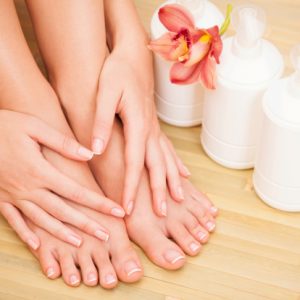 You walk on them, you squeeze them into shoes, and they can develop blisters, bunions and calluses, but our feet also can offer us so much more insight into our overall health than just helping us get up and about.
You walk on them, you squeeze them into shoes, and they can develop blisters, bunions and calluses, but our feet also can offer us so much more insight into our overall health than just helping us get up and about.
In fact, feet are so much more than five toes and a sole. They are comprised of joints, bones, muscles and soft tissue which all work together to perform their main function of allowing us to walk (and get out of bed in the morning). From the moment we are born, being able to walk is quite the accomplishment, but ignoring foot pain or telltale signs can lead you down a path of poor health.
Advertisement
The feet alone can carry their own complications. Gout, for example, causes inflammation in the foot where crystals form around the joints making it hard to use the foot properly. Ingrown toenails can cause infections when the toenail grows into the skin, also causing pain.
The most alarming foot-related illness is foot ulcers, to which diabetics are more prone. In a 2009 study conducted by the Department of Public Health and Primary Health Care in Norway, an estimated 50 percent of diabetics, within five years of diagnosis of foot ulcers, die because of the illness. Because of that alarming number, and circulation issues for diabetics, diabetics should get a checkup for their feet to prevent serious complications.
RELATED READING: Microwaving Kills Food Nutrients? 9 Health Myths Busted
Besides the physical connection, how are feet linked to the rest of your body? Well looking into these signs and symptoms will give you better insight into possible larger problems.
Thick And Yellow Nails: A stumped toe? Natural aging process? Actually, more like a fungus. Although unsightly to look at, a thicker, yellow nail means a thriving fungus. Besides the color, onychomycosis can be overlooked because sufferers may never feel pain from the condition. But don’t let that fool you, this fungus can definitely spread. The increase in thickness of the nail also can make it difficult to cut the nail and later cause pain.
These types of nails should be seen by a doctor for treatment with an anti-fungus or oral drug.
Bunions: Uncomfortable shoes are often to blame for the cause of bunions, but don’t start throwing out your high heels just yet, ladies, bunions are linked to poor foot structure. Bunions can be quite painful and often times require surgery to remove. Although your favorite shoes may be aggravating a bunion, you actually have genetics to blame for the formation of your bunions.
Numbness: Are you having trouble feeling your feet? As though there are constant pins and needles on them at all times? You may have some nerve damage, specifically peripheral neuropathy. The peripheral nervous system is what allows the rest of your body to communicate with itself. This condition can be caused by alcohol abuse or diabetes.
Other culprits can be tight shoes and circulation issues. Always ensure your shoe fits properly and has enough room for your feet for a comfortable fit. See your doctor when numbness occurs.
Pain: Whether it’s pain when you walk or run, or pain even when you are still, chronic foot pain should not be ignored. Sources of foot pain can be numerous, and that’s why it’s even more important get your feet checked.
Some common causes are fractures, osteoarthritis, and mechanical malfunction (specifically to the heel, or lack of arch). The position of the pain is also important to note to help with diagnosis. For example, if your pain is situated in your big toe, that can be a sign of gout.
There are different forms of treatment with any of these causes for pain, but to know for sure don’t let it slide; seek medical attention.
RELATED READING: 4 Ways Your Urine Can be Warning You About Your Health
Constant Foot Cramping: When it comes to foot health, foot cramping is probably the most vague to diagnose. It can cover anything from lack of nutrition and vitamins to circulation issues and nerve damage. Your best bet to start combating foot cramping would be to boost your intake of magnesium, calcium and potassium. Another relief method is soaking your feet in warm water while lightly stretching the foot and the toes.
If you still don’t find relief with these suggestions, have your feet examined for circulation or nerve issues.
A Sore That Won’t Heal: This symptom is significant; it’s a surefire way to diagnose diabetes. You’ve probably started to treat the sore and taken care of it and yet it still remains. Higher glucose levels can cause nerve damage in the feet. The body, therefore, cannot respond to healing the sore – it is unaware it is even present. If you are also experiencing frequent urination, weight loss and constant thirst, you should get checked for diabetes.
More extreme causes of a stubborn sore could signal skin cancer or an abnormal growth.
Keep Your Feet And Yourself Healthy
The importance of feet goes far beyond their primary function, so it’s important you keep them, along with yourself, healthy.
Here are some handy tips to keep your feet happy:
*Wear comfortable, breathable shoes and never share shoes with others
*Keep your feet dry and clean; cotton socks are the way to go
*Never ignore any pain or abnormalities on your feet
*Keep your toenails well trimmed and cut straight across
*Wear appropriate shoes for your setting – running shoes for the gym, walking shoes for the trail, steel toe for working environments
Give your feet some well-deserved TLC!
Advertisement
Related Reading:
